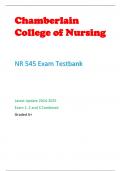Chamberlain
College of Nursing
NR 545 Exam Testbank
Latest Update 2024-2025
Exam 1, 2 and 3 Combined
Graded A+
,NR 545 EXAM 1
Allergic conjunctivitis: - Answer IgE mediated disease in response to triggers. Common triggers can be
seasonal such as grass, pollens, and mold. Persistent allergic triggers include dust mites and animal
dander.
Bilateral, itchy red eyes with rope like discharge and clear nasal discharge
Bilateral injected conjunctiva, clear discharge
Treatment based on identification and limiting exposure to allergen.
Medications include cromolyn ophthalmic drops, oral antihistamines, antihistamine eye drops
Viral conjunctivitis: - Answer Most commonly caused by the adenovirus.
Unilateral or bilateral red eyes, reports of current or recent viral infection, such as a UTI Unilateral or
bilateral injected conjunctiva, watery discharge No antibacterial therapy needed.
Virus resolves in 2-3 weeks
Bacterial conjunctivitis: - Answer Common bacteria include: Staphylococci, streptococci, chlamydial
organisms and gonococci. Some bacterial causes can be quite serious.
Gonococcal conjunctivitis can result in blindness and can indicate underlying systemic infection.
Usually unilateral, red and irritated
Eyelids are "stuck together" upon awakening.
Injected palpebral and bulbar conjunctiva, purulent drainage
Treatment is provided to decrease spread of contagion and shorten course of illness. Eye drop
treatments include Polymixin B plus trimethoprim or azithromycin.
,Otitis Externa - Answer inflammation of the externa ear canal, is also known commonly as swimmer's
ear. Occurring in both children and adults, otitis externa can present as a range of physical symptoms
from a minor inflammation to reports of intense pain. Otitis Externa Risk Factors
Swimming
Impacted cerumen
Use of hearing aids/ear plugs
Trauma from cotton tip applicators or other items used to clean ear canal
Foreign bodies
Anatomic causes: narrow ear canals, sharp angles in the ear canal or excessive hair in the canal
The normally acidic pH of the ear canal tends to inhibit microorganism growth. Swimming in a pool
where the pH is usually alkaline can result in altered pH of the ear canal. It is thought that it is this
alteration in pH creates a favorable environment for bacteria or fungal growth. The most common
causative agent is P. aeruginosa, other causes include Candida or Aspergillus species.
Common complaints (subjective findings):
Children: irritability, crying, disrupted sleep. Unilateral ear tugging, unilateral otalgia Adults: unilateral
otalgia
Physical exam (objective findings): Ear pain is increased upon palpation of tragus. The external ear canal
epithelium edema may extend from the pinna all the way to the tympanic membrane. Purulent or
serous discharge is noted in the canal.
Medication management depends upon the causative factors:
Pain management: OTC analgesics include ibuprofen or acetaminophen as appropriate for age and
weight
Bacterial Otitis externa can be treated with antimicrobial otic drops, which include polymyxin B plus
neomycin with or without hydrocortisone, ofloxacin, and ciprofloxacin HC otic drops
In cases of severe inflammation, insertion of an ear wick may be required to ensure medication
instillation to affected areas.
Otitis Media (AOM) - Answer Middle ear inflammation which results from and obstruction of the
Eustachian tube. The Eustachian tube dysfunction results in negative pressure within the middle ear,
enabling pharyngeal pathogens to be aspirated into the middle ear. The causes can be viral, bacterial or
allergy mediated.
Viral Most common cause of otitis which often occurs in association with an upper respiratory tract
infection. Most common organisms include respiratory syntactical virus, human rhinovirus, andenovirus
and influenza virus.
, Bacterial Colonization is a most often the result of fluid stasis from a respiratory virus. Streptococcus
pneumoniae and H. fluenzae are the most common bacterial pathogens found in middle ear fluid.
Allergic Responses resulting in inflammation can lead to obstruction of the Eustachian tube
Common complaints (subjective findings):
Otalgia, malaise, irritability, fever and vomiting, unilateral hearing loss, recent or current URI.
Can report itching or crackling noises in the ear.
Ear tugging or rubbing in infants and toddlers.
Physical exam (objective findings):
The outer ear may appear red.
The tympanic membrane is erythematous and possibly bulging or retracted.
Bony landmarks and light reflex absent.
Tympanic membrane may be ruptured resulting in otorrhea.
Most cases of acute otitis media resolve spontaneously and do not require treatment. Viral cases of
AOM resolve in 7-10 days with supportive care alone. Recommend PRN OTC analgesics and antipyretics.
Pain management OTC analgesics are offered for symptomatic relief Acetaminophen or Ibuprofen as
appropriate for age and weight. Topical otic analgesics such as
Auralgan Otic Solutions
Antibiotic therapy should be avoided in mild to moderate cases. Antibiotics are prescribed for those with
symptoms persisting for more than 2- 3 days, children under two years with bilateral acute otitis media
or bulging tympanic membranes and four or more symptoms or any person with otorrhea. First line
treatment for those without penicillin allergy Adults: amoxicillin OR Amoxicillin -clavulanate OR
cephalosporins for PCN allergy Children: amoxicillin OR Amoxicillin -clavulanate
Rhinitis - Answer an inflammation of the nasal mucosa that is usually accompanied by edema and a
profuse nasal discharge. Whether allergic or viral in nature, the rhinorrhea will be watery, speech will
sound nasal and there will be noted mouth breathing due to nasal edema. Bacterial rhinitis is discussed
within sinusitis, which is commonly referred to as rhinosinusitis.
Allergic Rhinitis - Answer IgE mediated diseases in response to triggers. Common triggers can be
seasonal such as grass, pollens, and mold. Persistent allergic triggers include dust mites and animal
dander
Subjective: pruritis of nasal passages, conjunctiva, and roof of mouth, sneezing coughing, sore throat,
seasonal presentation, usually pollen related
Objective: nasal turbinates edematous




